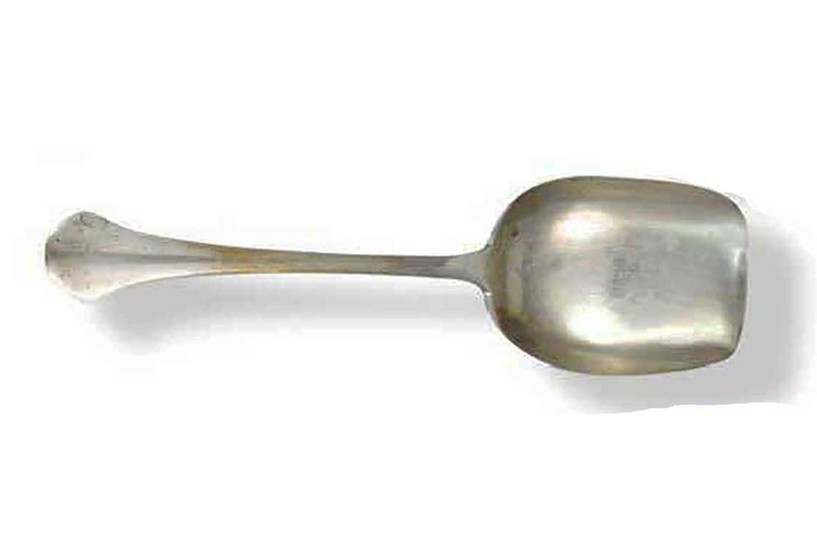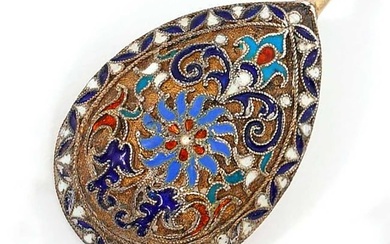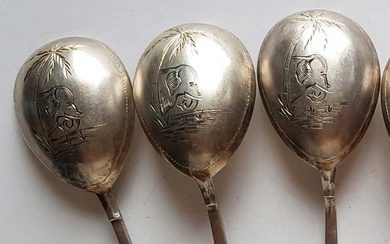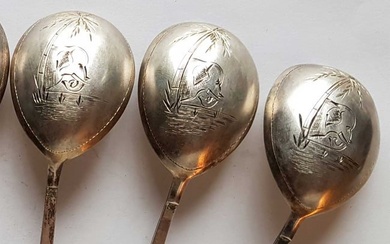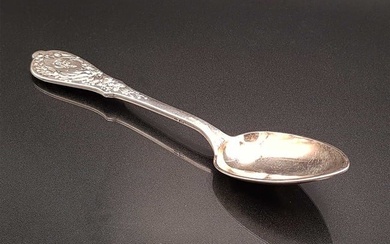RUSSIAN IMPERIAL SILVER SPOON, MARKED
RUSSIAN IMPERIAL ENGRAVED SILVER SPOON, MARKED 84
The spoon having an engraved elephant design on the back of spoon.
It has a mark: 84 for silver.
SIZE: 115 x 30 x 10 mm (4 1/2 x 1 x 1/4 inches). Weight: 14 grams.
ESTIMATE PRICE: $150 - $300.
HISTORY of SALES: Recently the same style of item was sold on eBay for $709 - please see the screenshot.
OFFER: If an item is NOT SOLD, you can still give us a reasonable offer - please save the link of this page.
PAYMENT: Credit Card payment, Wire transfer, Check or Money Order payment are also available. International bidder can use PayPal for payment.
PAY in PARTS: You can pay for any item during 2 - 3 months. Just make a deposit 10% and the item will wait for you.
SHIPPING: Let us Handle Your Shipping. We are one of the few places that offer full service shipping. For your convenience we will ship your item - shipping costs will be included in the invoice. Combined shipping is available - next item will be ONE DOLLAR for shipping.
NEW: Returning customers will have FREE SHIPPING in USA and 50% DISCOUNT on international shipping.
WIKIPEDIA: A silversmith is a metalworker who crafts objects from silver. The terms silversmith and goldsmith are not exactly synonyms as the techniques, training, history, and guilds are or were largely the same but the end product may vary greatly as may the scale of objects created. In the ancient Near East the value of silver to gold being less, allowed a silversmith to produce objects and store these as stock. Ogden states that according to an edict written by Diocletian in 301 A.D., a silversmith was able to charge 75, 100, 150, 200, 250, or 300 denarii for material produce (per Roman pound). At that time, guilds of silversmiths formed to arbitrate disputes, protect its members' welfare and educate the public of the trade. Silversmiths in medieval Europe and England formed guilds and transmitted their tools and techniques to new generations via the apprentice tradition. Silver working guilds often maintained consistency and upheld standards at the expense of innovation. Beginning in the 17th century, artisans emigrated to America and experienced fewer restrictions. As a result, silver working was one of the trades that helped to inaugurate the Technological and industrial history of the United States Silver-working shift to industrialization in America.
View it on
Estimate
Time, Location
Auction House
RUSSIAN IMPERIAL ENGRAVED SILVER SPOON, MARKED 84
The spoon having an engraved elephant design on the back of spoon.
It has a mark: 84 for silver.
SIZE: 115 x 30 x 10 mm (4 1/2 x 1 x 1/4 inches). Weight: 14 grams.
ESTIMATE PRICE: $150 - $300.
HISTORY of SALES: Recently the same style of item was sold on eBay for $709 - please see the screenshot.
OFFER: If an item is NOT SOLD, you can still give us a reasonable offer - please save the link of this page.
PAYMENT: Credit Card payment, Wire transfer, Check or Money Order payment are also available. International bidder can use PayPal for payment.
PAY in PARTS: You can pay for any item during 2 - 3 months. Just make a deposit 10% and the item will wait for you.
SHIPPING: Let us Handle Your Shipping. We are one of the few places that offer full service shipping. For your convenience we will ship your item - shipping costs will be included in the invoice. Combined shipping is available - next item will be ONE DOLLAR for shipping.
NEW: Returning customers will have FREE SHIPPING in USA and 50% DISCOUNT on international shipping.
WIKIPEDIA: A silversmith is a metalworker who crafts objects from silver. The terms silversmith and goldsmith are not exactly synonyms as the techniques, training, history, and guilds are or were largely the same but the end product may vary greatly as may the scale of objects created. In the ancient Near East the value of silver to gold being less, allowed a silversmith to produce objects and store these as stock. Ogden states that according to an edict written by Diocletian in 301 A.D., a silversmith was able to charge 75, 100, 150, 200, 250, or 300 denarii for material produce (per Roman pound). At that time, guilds of silversmiths formed to arbitrate disputes, protect its members' welfare and educate the public of the trade. Silversmiths in medieval Europe and England formed guilds and transmitted their tools and techniques to new generations via the apprentice tradition. Silver working guilds often maintained consistency and upheld standards at the expense of innovation. Beginning in the 17th century, artisans emigrated to America and experienced fewer restrictions. As a result, silver working was one of the trades that helped to inaugurate the Technological and industrial history of the United States Silver-working shift to industrialization in America.
